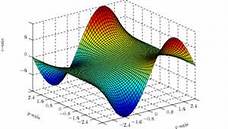
The methods discussed in previous tabs (refer to menu) "ODE - Euler Method" and
"ODE - 2nd-Order Runge-Kutta" and
"ODE - 4th-Order Runge-Kutta" apply
to only a single first-order ordinary differential equation as described in these tabs.
However, most problems in
engineering governed by differential equations are either high-order equations or coupled differential equation
systems.
A high-order differential equation can always be transformed into a coupled first-order system of equations. The trick is
to expand higher-order derivatives into a series of first-order equations.
A very common example described in technical literature
applies to model a spring-mass system with damping, which describes the use and calculation of second-order differential equations.
We followed very closely these techniques for our own implementation.
|
m d2x / d t2 = -kx - b dx/dt |
|
where k is the spring constant and b is the damping coefficient. Since the velocity:
the equation of motion
for a spring-mass system can be rewritten in terms of two first-order differential equations:
dv/dt = -k/m x - b/m v
dx/dt = v |
In the above equation, the derivative of v is a function of v and x, and the derivative of x is a function
of v. Since the solution of v as a function of time depends on x and the solution of x as a function of time
depends on v, the two equations are coupled and must be solved simultaneously.
Most of the differential equations in engineering are higher-order equations. This means that they must be expanded
into a series of first-order differential equations before they can be solved using numerical methods.
The next tab shows extending the fourth-order Runge-Kutta method discussed previously to a system of ordinary
differential equations.
|